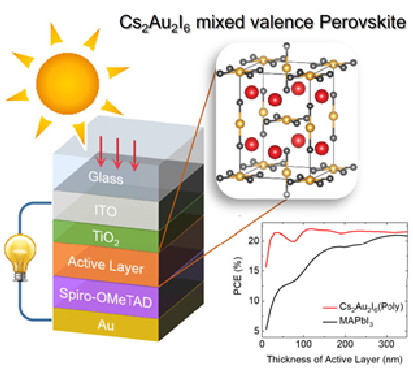Jun
14
Lead Free Perovskite Solar Cell Proposed
June 14, 2018 | Leave a Comment
A Korea Advanced Institute of Science and Technology (KAIST) research team has proposed a perovskite material that serves as a potential active material for highly efficient lead-free thin-film photovoltaic devices. This material is expected to lay the foundation to overcome previously known limitations of perovskite including its stability and toxicity issues.
The KAIST research team has proposed a perovskite material, Cs2Au2I6 (Cesium, Gold, Iodine) that serves as a potential active material for highly efficient lead-free thin-film photovoltaic devices.

Schematic of full solar cell device structure. Image Credit: KAIST. Click image for the largest view.
As strong candidates for next-generation high-efficiency photovoltaic cells, perovskite photovoltaic cells have a maximum photoconversion efficiency of 22%, comparable to high-performance crystalline silicon photovoltaic cells. In addition, perovskite-based cells can be fabricated at low temperatures, thereby bringing about dramatic cost reductions.
However, it has been noted that conventional organic-inorganic hybrid perovskite materials exhibit low stability, eventually degrading their performance and making them unfit for continued use. Moreover, their inclusion of lead has undermined their environmental friendliness.
So, a joint team led by Professor Hyungjun Kim from the KAIST Department of Chemistry and Professor Min Seok Jang from the School of Electrical Engineering has analyzed a previously discovered perovskite material, Cs2Au2I6, consisting of only inorganic substances and investigated its suitability for application in thin-film photovoltaic devices. Theoretical investigations suggests that this new perovskite material is not only as efficient but also more stable and environment friendly compared to the conventional perovskite materials.
For this analysis, the team developed multiscale multiphysics simulation frameworks. Atomic-scale first-principle quantum calculations were carried out to study the optical properties of the proposed material, and device-scale electromagnetic simulations were conducted to suggest that the material could indeed serve as a promising photovoltaic substance at the device level.
From this point onward, the research team plans to extend the study in two directions: an empirical study to apply the perovskite material in real-world photovoltaic cells and a theoretical analysis to find the optimal and highly stable material for photovoltaic cells
The team said, “Perovskite materials are highly efficient, but in order to completely replace the conventional solar cells, their stability and toxicity issues must first be resolved.” They added that this research is expected to accelerate related studies in pursuit of high-efficiency, environment-friendly perovskite materials.
This research is being led by post-doc researcher Lamjed Debbichi and master’s candidate Songju Lee. The research paper has been published and selected as the front cover article of Advanced Materials.
This looks good for the perovskite field. The concern right off is the Cesium, which isn’t particularly inexpensive and the gold which surely is not cheap. Iodine probably won’t have much impact. There are also the requisite matters of manufacturing, scaling up, longevity and recycling to work through. This looks like finally a lead free start for perovskite. Congratulations KAIST!

